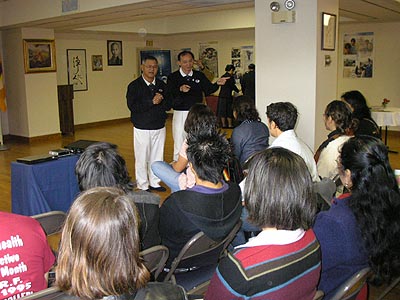|
|
|
|
克城消息
|
| |
|
|
|
|
Oberlin Students Searching For Chinese America
|
|

|
|
|
|
編者按:本報在一個多月前接到OBERLIN COLLAGE
歷史系李今朝敎授來電,她説她想要帶她的學生來伊利華報和長靑公寓參觀,李敎授想讓她的學生走出課堂去實地考察。李敎授來自Hawaii,她在電話里十分客氣地説:她到克里夫蘭後慢慢喜歡這個地方了,是華報給她帶來許多消息和音訊,她是敎社會學的,本學期敎的是美國歷史,她發現美國歷史很少有記載中國華人和華人社區的事,尤其中部地區幾乎沒有。她現在是在硏究和探索華人在美國的社會現象以及美國太平洋地區的華人實際生活情况。
高等敎育走出象牙塔,這是新學術運動,這也是她帶學生走訪中國社區的目地,她希望他們能親眼目睹華人的生活,看他們的文化背景甚至帶他們看中國超市場,培養和鼓勵他們能更深瞭解中國華人在美國的生活,同時她還説了最新敎育的改革,高等敎育的新方法是:學校和社區相結合,從社區出發。中國歷史文化敎育在美國還有很長的路要走,需要大家一起努力,讓更多的美國人瞭解中國的歷史和文化,瞭解中國的現狀。
|
|
|
|
|
|
On September 30, the “Asian American History” class
from Oberlin College had a great opportunity to visit four significant
Chinese American social organizations and cultural institutions in the
Cleveland area. They were the Erie Chinese Journal, the Asian
Evergreen Apartment Building (which was under the care of Cleveland
Chinese Senior Citizens Association and Asian Evergreen Housing
Corporation), Tzu Chi Foundation Cleveland Service Center, and Tink
Holl Food Market. For the first time in years, Oberlin College
students paid a formal visit as a class to the Chinese American
community in the Cleveland area. They all felt that the trip was very
informative, inspiring, and thought-provoking.
The purpose of the visit was three fold. First, to provide the
students an opportunity to compare the textbook material with
real-life examples and experiences of Chinese Americans. Second, to
enable students to develop interest in studying Asian Americans in the
Midwest, whose history is still largely under-researched and
under-written. Third, to make students join the nation-wide “service
learning” movement, a new pedagogy that guide college students out of
the Ivory Tower and engage them in community-based learning and
research.
The four places of our visit represent different aspects of Chinese
American community in the Cleveland area. The Erie Chinese Journal,
one of the most popular and most accessible Chinese newspapers that
circulate among Cleveland, Columbus, and Pittsburg Asian American
communities in the past four years, serves as an example of how ethnic
media is managed and sustained on daily basis and how it creates and
represents a community. Many students were deeply impressed by Madame
Pu Ying’s optimism, high-level energy, and perseverance, which to them
represent the pioneering spirit of many first-generation immigrants to
the United States. The Asian Evergreen Apartment Building, the one and
only Asian American seniors’ house in Cleveland, gathers many Asian
Americans that settled in the United States in the early and mid
twentieth century. Their diverse cultural, national, and regional
background provides the students a glimpse of the diasporic and
multi-settlement experience of Asian Americans and the fast growth of
Asian American population in Northeast Ohio. After our meeting with
some of the senior residents, two students who speak Mandarin and
Vietnamese immediately expressed interest in collecting oral history
there and sought contact information for further arrangement. Our
visit to Tzu Chi was an eye-opening experience to all of the students.
None of the eighteen students had ever heard about Tzu Chi Foundation
before. Neither had they thought about the relationship between
Buddhist belief and social service movement. After learning about the
origin of Tzu Chi Foundation and its involvement in international
charity events, a couple of students suggested that the Foundation
should be introduced to Oberlin students and asked about doing a
winter or summer internship with the Foundation. At the Tink Holl Food
Market, the students observed the material culture of Asian Americans
and the existence of a wide range of cultural objects, from long-term
to more recent ones, from cross-culturally-shared to more ethnically
specific items. They came to understand how the ethnic market
functions as a community space and “a home away from home.”
Aside from these four Chinese and Asian American sites, some students
also stopped by the Cleveland Culture Gardens to see how the diversity
of Ohio’s immigrant history is remembered and represented. As they saw
the newly finished Indian Garden, they began to contemplate which
group will be the next – Japanese? Taiwanese? Mexican? …
We sincerely hope that our one-day field trip is the beginning of a
long-term partnership between Oberlin College and the Chinese American
community in the Cleveland area. We hope that through our concerted
and sustained efforts Asian America will have a fairer place in the
past, present, and future of the Midwest, America’s Heartland. |
|
|
|
|
|
|
|
|
|
|
 |
|
|
 |
|
|
|
|
|
|
 |
|
|
|
|
|

|
|
|
|

|
|
|
|

|
|
|
|

|
|
|
|

|
|
|
|
|
|
|
|
|
|
|
|
|
|
|
|
|
|
|
|

|
|
|
|

|
|
|
|

|
|
|
|

|
|
|
|

|
|
|
|

|
|
|
|

|
|
|
|
|
|
|
|
|
|
|
|
|
|
|
|
|
|
|
|
|
|
|
|
|
|
|
|
|
|
|
|
|
|
|
| |
| |
|
|